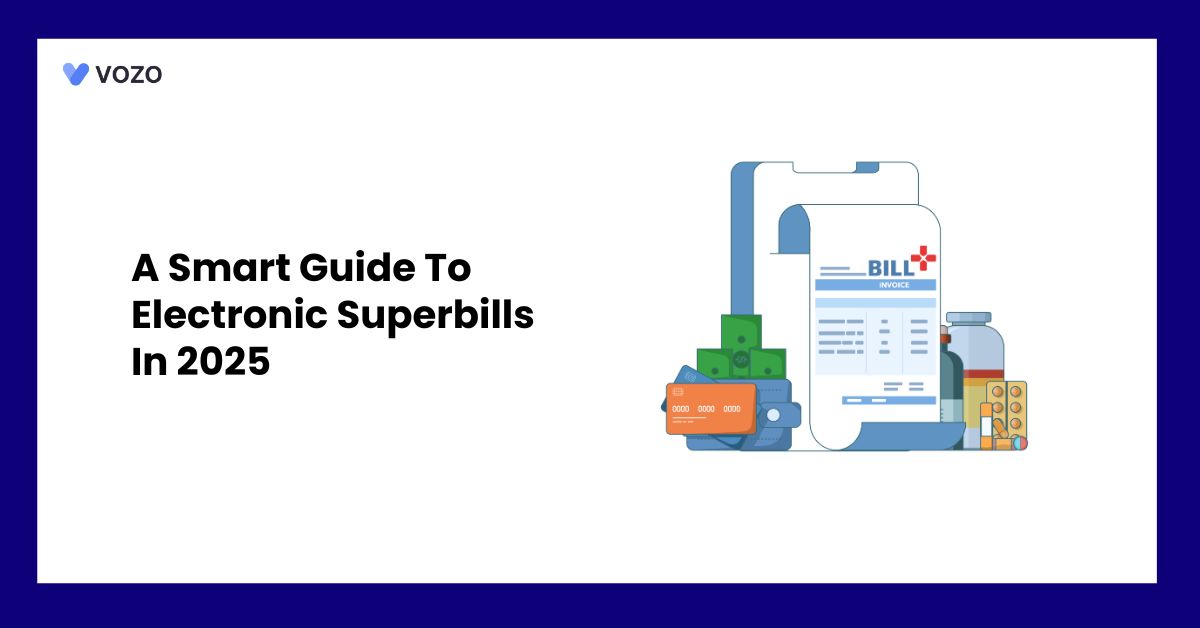A Smart Guide To Electronic Superbills In 2025
Both patients and providers may feel overloaded by insurance reimbursement. Patients get confused about the bills, such as the services mentioned, and the medical codes. This can hinder them from appealing for reimbursement.
In order to solve this, superbills are created, as they contain all the information related to the services offered to the patients. In this blog, you’ll learn what superbills are, the core elements of superbills, and how they support the reimbursement process.
What is a Superbill in Healthcare?
A superbill is a thorough billing document that medical professionals generate for the services they deliver to patients. It is a primary source of information for clients to seek reimbursement from their insurance provider.
Superbills are different from regular invoices since they include diagnostic codes and particular codes like CPT and ICD codes.
Importance of a Superbill
Under insurance superbill is used for patient reimbursement. Depending on the plan’s benefits, you might have to pay a copay at the time of service. To cover the balance bill, the provider needs to submit a claim to the insurance company.
During services from a physician, therapist, or diagnostic center outside the plan, you need to pay out of pocket. In this case, you can file an out-of-network claim with your insurance provider. Superbill gives you the detailed information you need to reimburse accurately.
Components of a Superbill
1. Provider Information
This section contains all the relevant information about the healthcare practice involved in providing the services.
- Provider’s first and last name
- Practice Address
- Provider email address
- Provider phone number
- Provider signature
- Provider NPI number
- Provider’s license number
- Referring provider’s name
- Referring provider’s contact details
2. Patient Information
Updated patient information is required for generating superbills and the reimbursement process.
- Patient name
- Date of birth
- Address
- Contact details
- Insurance information like type, name, and ID number
3. Service Information
Treatment information requires attention for accuracy. It includes all the data related to the services offered for the patients, such as diagnosis and procedural codes.
- Date of service
- Place of service
- Modifiers
- Diagnosis code like ICD-10
- CPT and HCPCS codes
- Time spent in units or minutes
- Cost for each service or procedure
Related: How Text-to-Pay Simplifies Payment Processing for Modern Healthcare Practices
Types of Superbill
Superbills are generally of 2 types: one is insurance-focused or patient-specific, depending on who is submitting the claim.
1. Insurance-Focused Superbills
Some healthcare practices or providers generate medical documents according to insurance company requirements. It includes all the information, such as ICD-10 and CPT or HCPCS codes for claim processing. These superbills are created to ensure smooth processing.
2. Patient-Specific Superbills
This is the most common type of superbills. Providers generate documents for the patients who submit a superbill to their insurance company to seek reimbursement. Patients are responsible for the services received or a filing a claim based on the superbill.
Benefits of Superbills
Superbills are also known as encounter forms that bring benefits to both providers and patients. They lower mistakes and claim denials while streamlining the billing process, including paperwork.
1. Transparency
Superbills provide transparency by enabling people to understand the costs associated with their medical care. Superbills provide them with a detailed document that includes diagnosis, provided services, and costs associated.
2. Reducing out-of-pocket expenses
Patients can reduce their out-of-pocket costs by submitting superbills to insurance carriers. Invoices allow users to claim a portion of their healthcare expenses.
3. Improved Documentation
Superbills help with the documentation, and providers can maintain detailed records of the patient visits. This improves documentation and easy to manage patient billing.
4. Faster Reimbursements
It reduces the waiting time instead of weeks for a paycheck and endless paperwork. Providers get paid quickly for their health services.
5. Accurate Billing
Insurance billing is complicated; it requires a detailed report on each service with its costs and medical codes, which reduces the risk of billing errors. Improves billing accuracy, leading to fewer denials and faster payments.
Major Errors in Superbills to Avoid
- Claim denials may arise from the use of out-of-date or inaccurate codes, such as CPT and ICD-10 codes.
- Claims processing may be delayed by missing or incorrect data, such as diagnostic codes, patient information, or provider NPI.
- Submitting the same claim to multiple insurance companies can lead to claim rejections.
- Lack of proper documentation or incomplete medical history can cause claim denials.
- Not verifying insurance information before claim submission.
How Superbill Supports Clients Through Reimbursement
- Help your patients understand the superbill by going over each component with them and emphasizing the crucial information, such as diagnostic codes, CPT codes, and costs.
- Provide advice and communication to the insurance firm, such as thorough phone logs, reference numbers, and elevating concerns to higher-ups.
- Inform clients to keep extra copies of any documentation related to the insurance process.
- Provide them with the general guidance on the reimbursement process and avoid talking about specific insurance plans or reimbursement amounts.
Related: A Provider’s Guide to Solving Medical Billing Issues with Integrated Payment Solution
Vozo Cloud EHR Integrated with Medical Billing
Medical billing is a complex healthcare operation that requires efficiency and precision. Delayed payments, claim denials, and manual errors can slow your revenue cycle and affect cash flow.
With Vozo’s Cloud EHR solution, you get an integrated medical billing system that simplifies your billing process and enhances real-time claim tracking to improve payment turnaround.
How Vozo EHR Transforms Medical Billing:
- Streamline billing workflows and reduce administrative workload.
- Instantly identifies and corrects coding errors before claim submission.
- Speeds up claim verification with automated payer communication.
- Ensures compliance with built-in coding checks and regulatory updates.
- Offers real-time analytics and reporting for better decision-making.
- Minimizes delays by automating claims processing and payments.
- Reduces billing disputes with accurate, transparent invoicing.
Vozo EHR’s seamless integration with medical billing empowers healthcare providers to reduce errors, prevent delays, and optimize revenue cycles, all while focusing on delivering better patient care.
About the author

With more than 4 years of experience in the dynamic healthcare technology landscape, Sid specializes in crafting compelling content on topics including EHR/EMR, patient portals, healthcare automation, remote patient monitoring, and health information exchange. His expertise lies in translating cutting-edge innovations and intricate topics into engaging narratives that resonate with diverse audiences.













